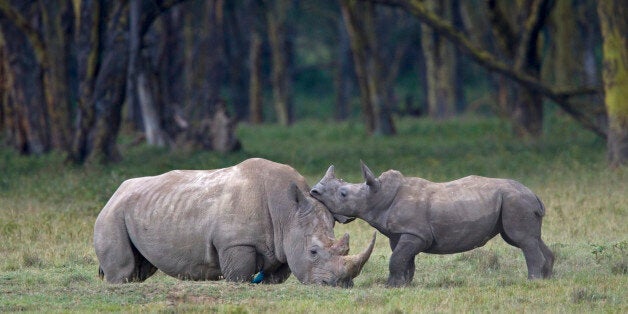
The deaths of two aging Northern white rhinos in zoos in San Diego and the Czech Republic brought the species closer to extinction over the past year, with only four left on the planet.
On World Rhino Day, September 22, the rhino is on the edge of extinction. All too often, we don't recognize a problem that has been crying out for attention until we're dangerously close to the point of no return.
The outpouring of support for Sudan, the last male Northern white rhino, has been powerful. Kept under 24-hour armed guard in Kenya, he's the subject of a #LastManStanding Twitter campaign that has helped raise awareness of the plight of the rhinoceros. Yet the odds for the Northern white rhino are grim. The only way the Northern white rhino will survive is if one of the remaining females - ailing Nola (41), Fatu (15), and Najin (25) - can conceive. With Sudan over 42 years old and with a critically low sperm count, those odds are not good.
A dramatic rise in poaching, fueled by new demand from Asian markets, could bring the rest of the world's rhinos to extinction within a decade if we don't turn the tide. In fact, in recent years we've already seen some sub-species, like the Western black rhino, disappear from the planet entirely. Others survive only in zoos, with none left in the wild.
Just a century ago, there were a half million rhinos on the planet. Today, there are fewer than 100 Sumatran rhinos left, and only one still in the wild in Malaysia. Only 60 Javan rhinos remain in Indonesia; the last one alive in Vietnam was poached in 2010.
Yet there is hope. There are about 3,000 remaining of largest rhino, the Indian or greater one-horned rhinoceros, a population that has grown more than five-fold since conservation efforts began in the 1970s.
Similarly, there are just over 20,000 white rhinos and just over 5,000 black rhinos alive, mostly in Africa. These populations threatened again by a dramatic rise in poaching. Yet both have risen from earlier lows -evidence that where there is a will, there is a way.
How do we keep the rhinoceros on the planet? Like so much in the world the answer comes down to one thing: Show me the money. We need to make rhinos more valuable alive than dead.
There are four ways to accomplish that:
Use the power of knowledge to fight poaching and reduce demand. Rhino horn is only valuable because people are willing to pay for it. Archaic and inaccurate notions about its supposed health benefits have driven the price of rhino horn up as Asian economies have prospered. Demand has increased dramatically, particularly in Vietnam and China, and so unfortunately has poaching and the slaughter of rhinos. We need knowledge to increase more quickly than people's ability to purchase a substance that has no more medicinal value than fingernail clippings.
The UK conservation group Save the Rhinos is celebrating World Rhino Day with a #NailItforRhinos contest and social media campaign, urging people to paint their finger and toenails with rhino themes to drive home the point that rhino horn is made out of the same substance -keratin. (The contest is open through September 30.)
Celebrities standing up for rhinos include names as varied as Princes William and Harry, Virgin Group founder Richard Branson, kung fu star Jackie Chan, basketball phenomenon Yao Ming, Chinese actress Bai Ling, comedian Stephen Fry, tennis great Martina Navratilova, Pink Floyd guitarist David Gilmour, Bollywood star Nargis Fakhri and Egyptian TV host Khaled Naga. The more well-known personalities who stand up to spread the message, the faster we can cut demand for rhino horn.
Go after the crime syndicates where it hurts: their bank accounts. The same goes for the countries that shelter them. Earlier this year, 31 countries signed an agreement to pursue criminal networks laundering roughly $10 billion a year in illicit funds from poaching and trading. The International Rhino Foundation has partnered with the Environmental Investigation Agency to petition the United States to place trade sanctions on Mozambique for its support of criminal syndicates that have aggressively targeted rhinos. China and Vietnam need to be pressured to be more aggressive in cracking down on the criminals who import and distribute rhino horn. Trade accords, national laws like the Lacey Act in the United States, and international agreements can be used to crack down on nations that turn a blind eye to poaching and criminal trades.
Support creative anti-poaching strategies and aggressive enforcement. Rhino defenders are now using technology to catch up with poachers: night-vision goggles, DNA testing, drones and big data crunching, along with good old-fashioned canine units. Alert tourists have contributed to the fight against poachers. Conservation organizations believe that a recent effort to use 3-D printing to substitute for rhino horn appears more likely to hurt than help the rhino; they argue that the substance would provide a cover for illegal rhino horn and increase demand, increasing smugglers'profits.
Increase the value of living rhinos. South African President Paul Kruger in 1898 founded what is now Kruger Park precisely because he recognized that hunters were reducing the wildlife at an alarming rate and that if species like rhinos, lions, and elephants were to survive, they needed a refuge. In turn, these animals attract tourist dollars that supported countries that understand the economic value of conservation. Tourism generates more than $70 billion a year in Africa, close to 4 percent if its GDP. And as controversial (and to me personally repugnant) as it is, there is a place for responsible hunting. The remarkable rebound of the white rhino population has been credited in part to South Africa's authorization of limited legal hunting permits. A 2005 study in the Journal of International Wildlife Law and Policy recommends permits to hunt only older, non-breeding males if revenue goes straight to conservation.
Governments and larger organizations are not the only part of a successful strategy to save the rhino. There's an essential place for each one of us in rhino conservation.
What can YOU do?
Go see a living rhino. Even being near one of these magnificent creatures in the zoo provides a powerful connection to the rhinoceros, which has walked the earth for more than 50 million years, and a better understanding of how important it is to save them
Even better, invest in seeing rhinos live in the wild. By supporting jobs in the communities on which rhinos depend for their existence, you'll reinforce the message that rhinos are valuable both in the places where they live and around the world. Finally, add your voice to the effort to educate others. Use your social media feeds to raise awareness of the value of the rhino.
It may be too late for the Northern white rhino, but it's not too late for the rest of the rhinos.
